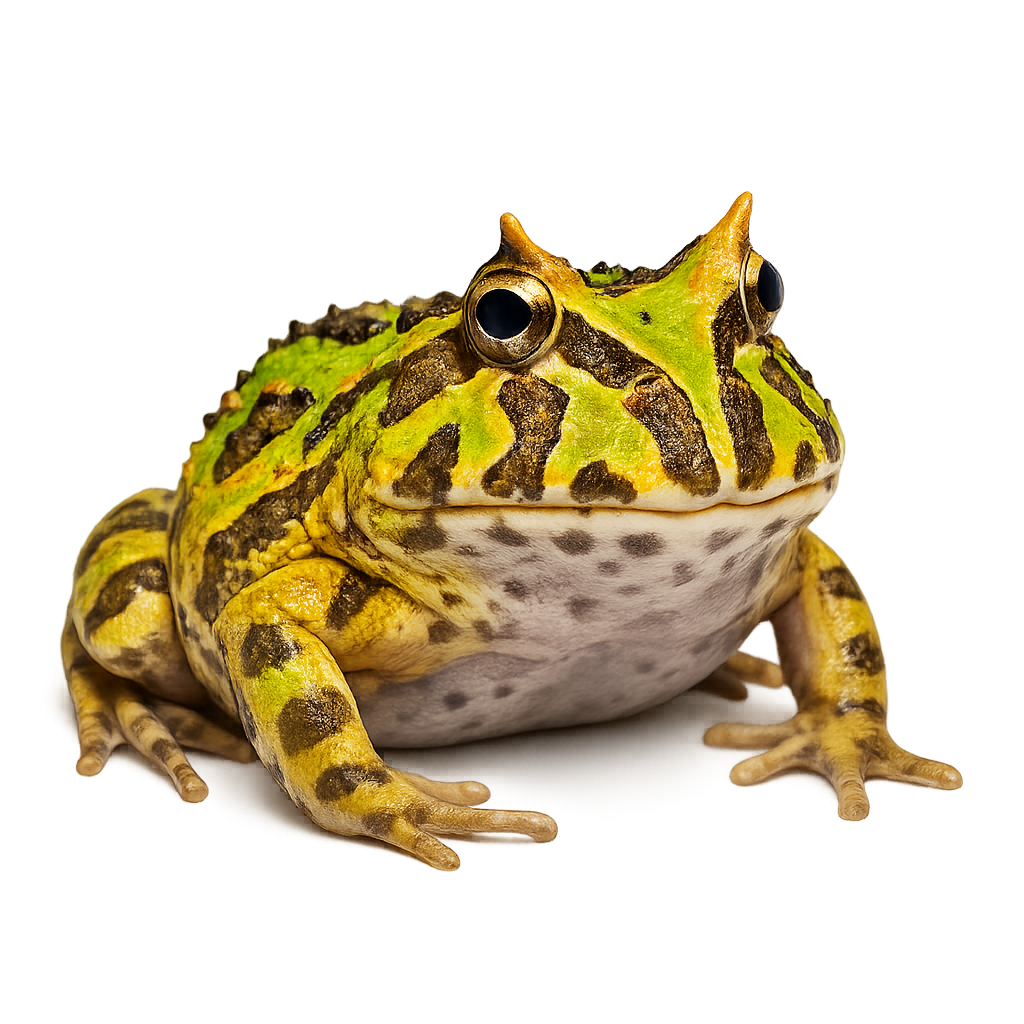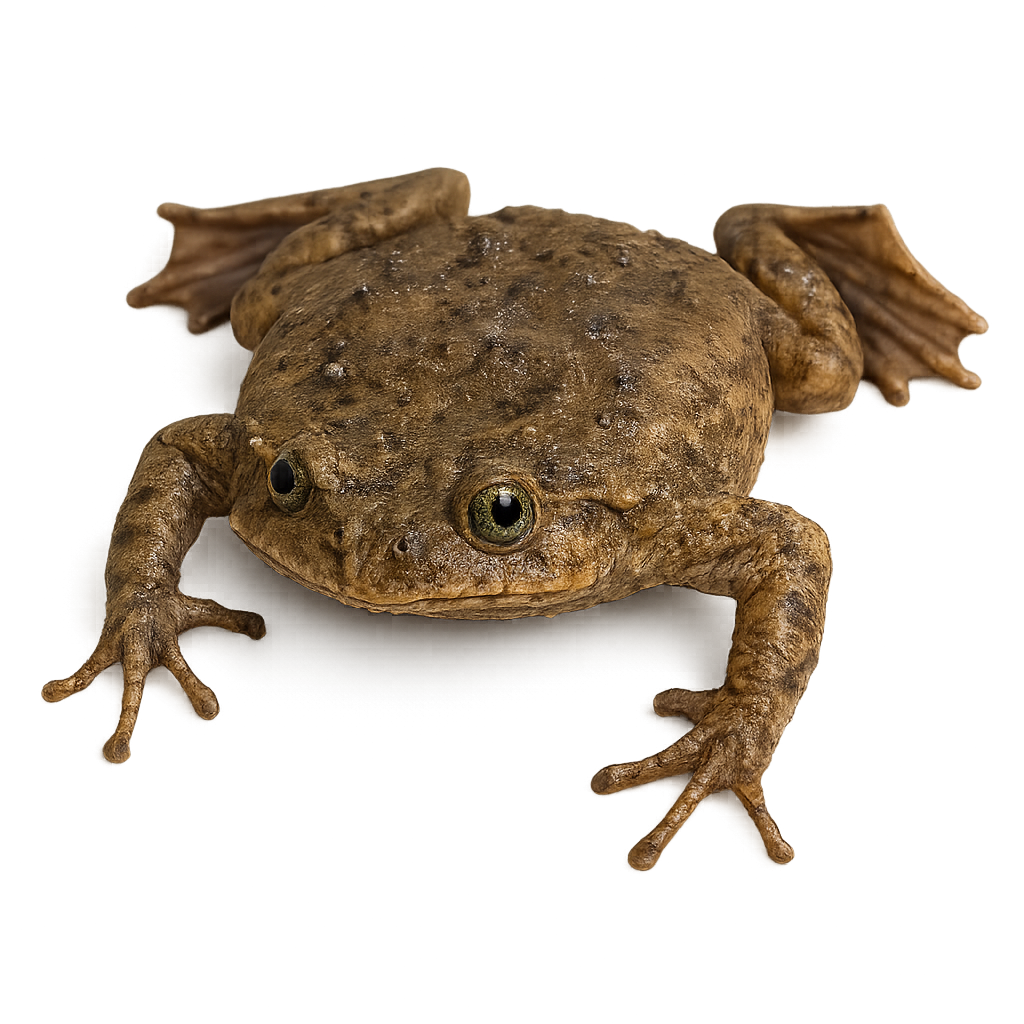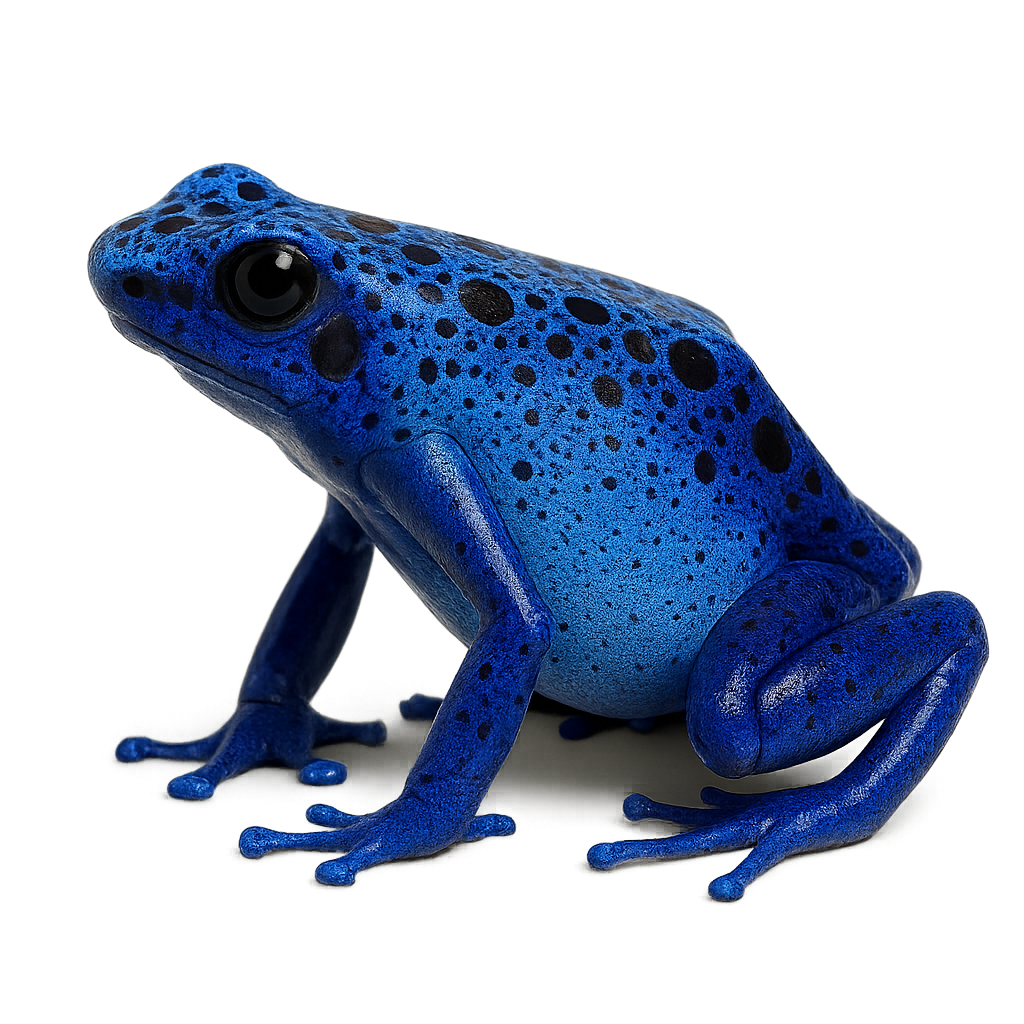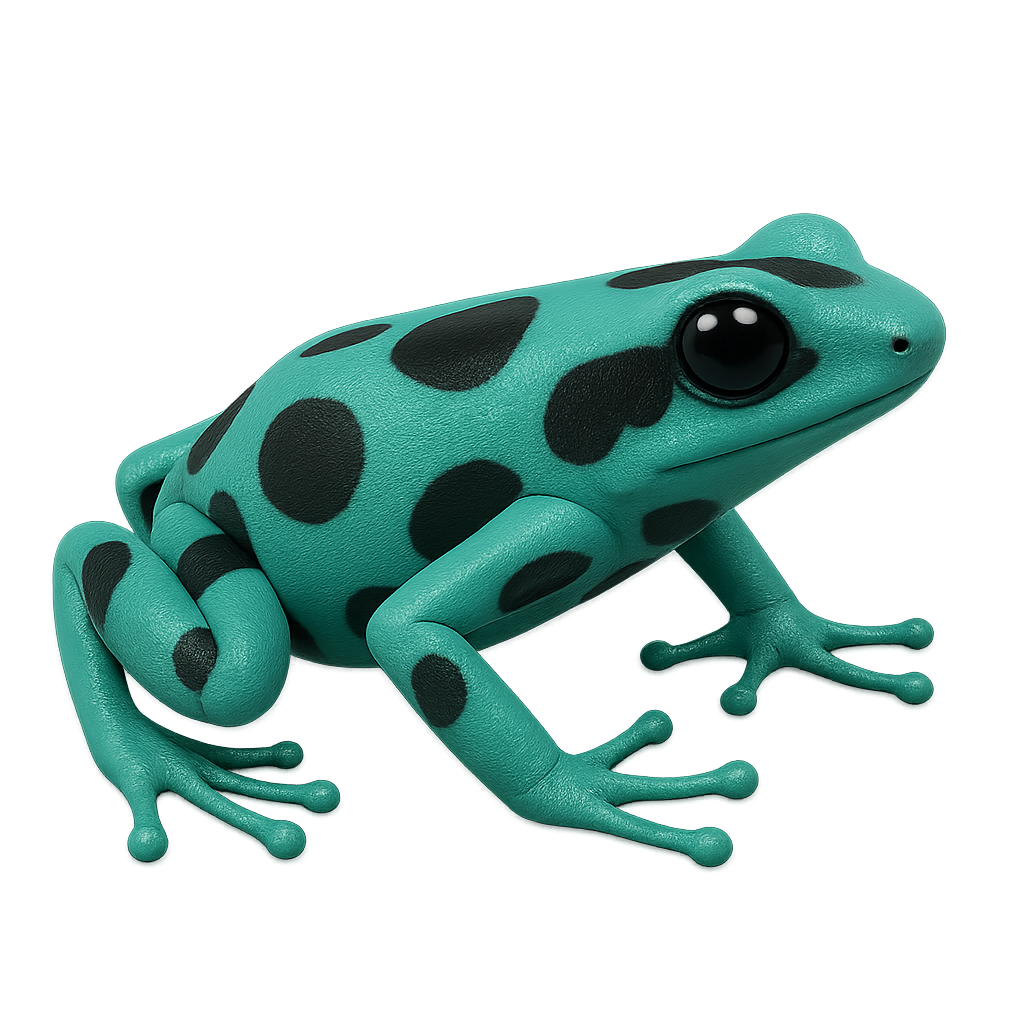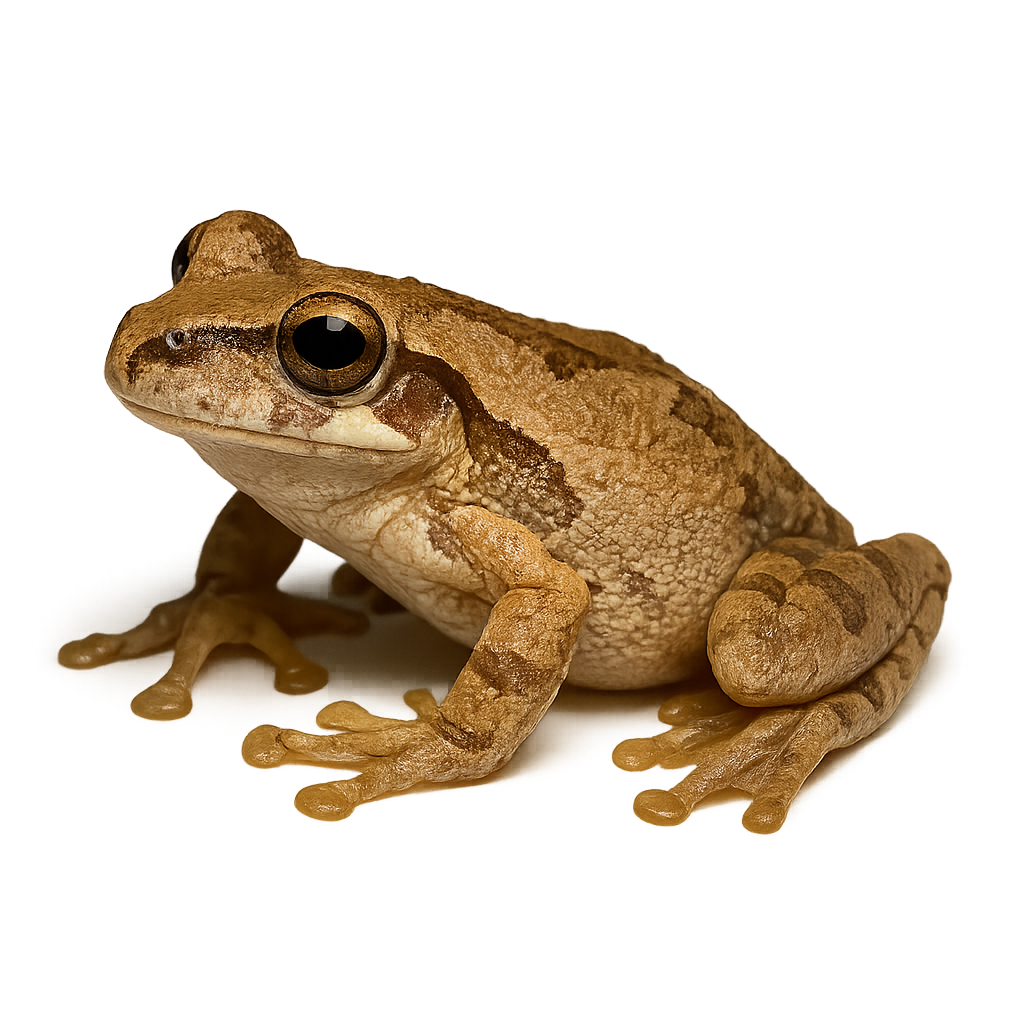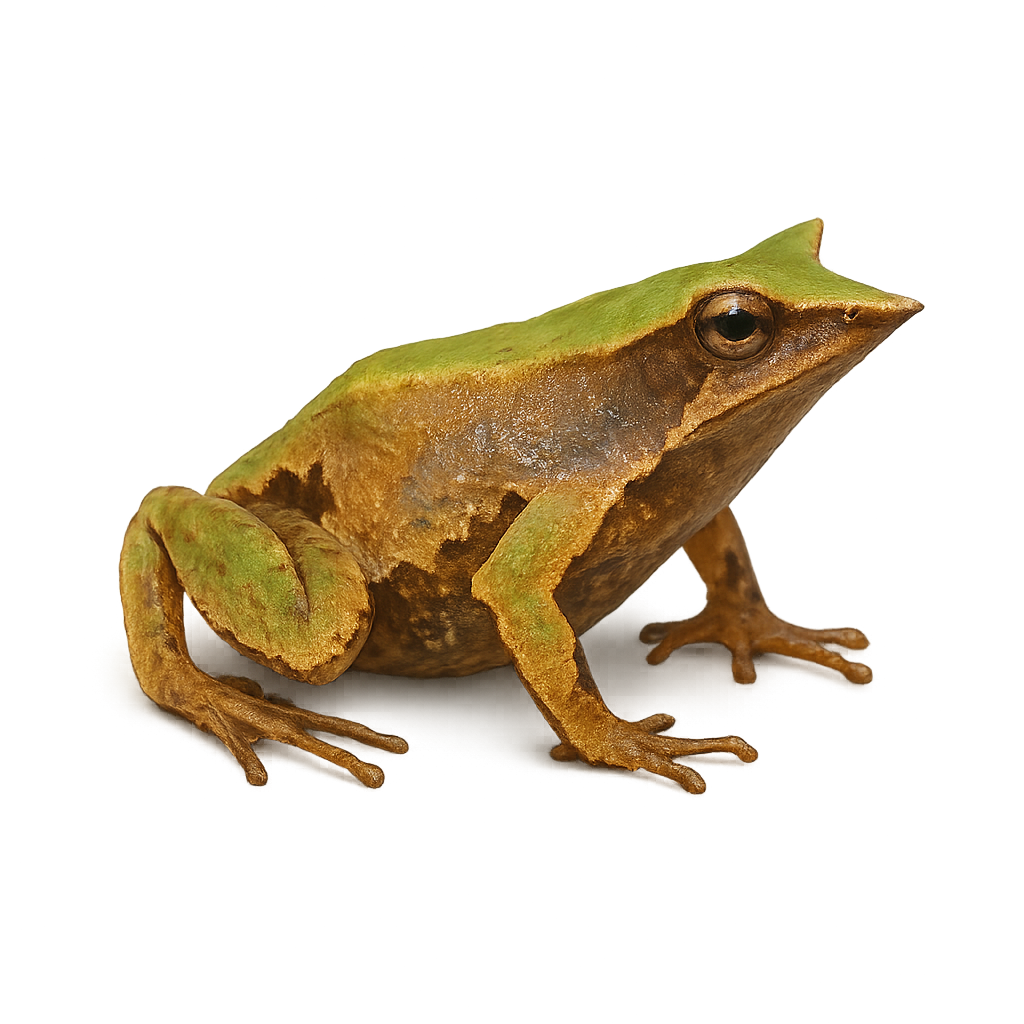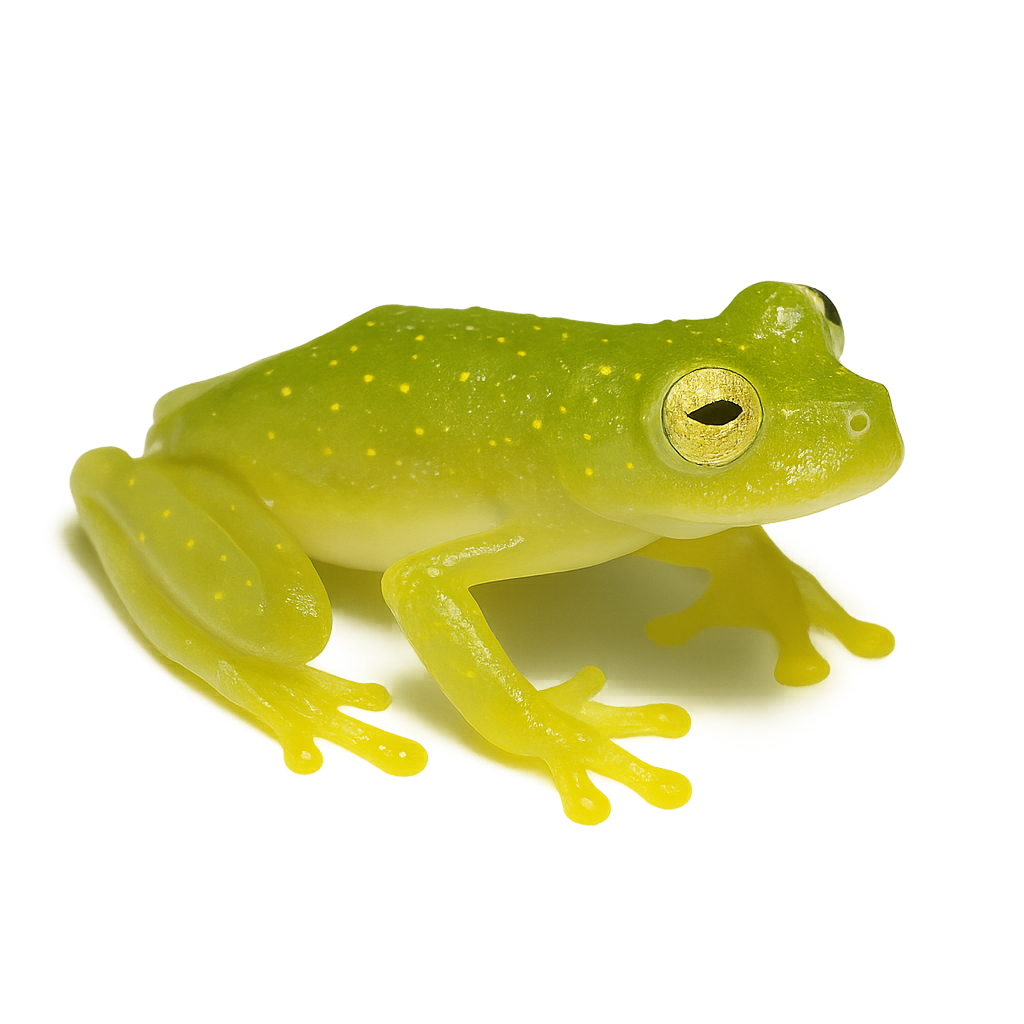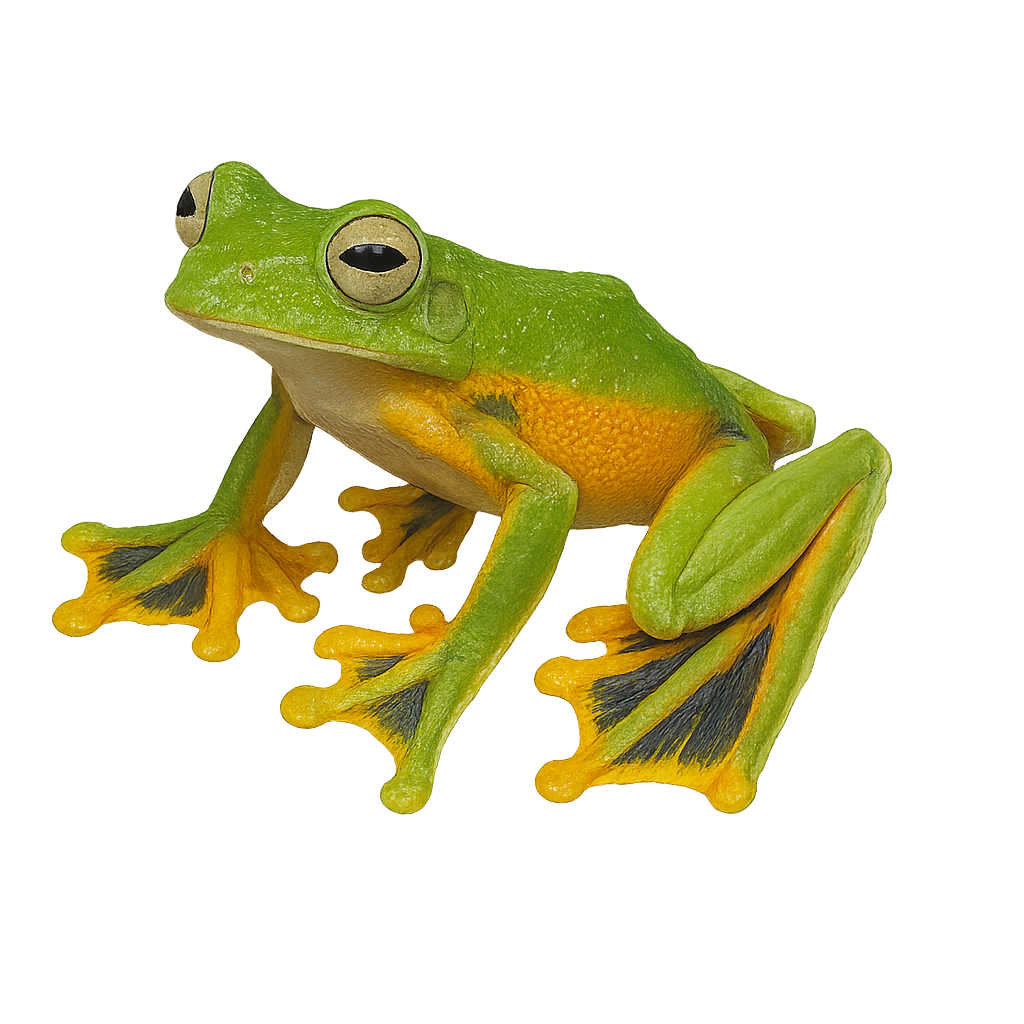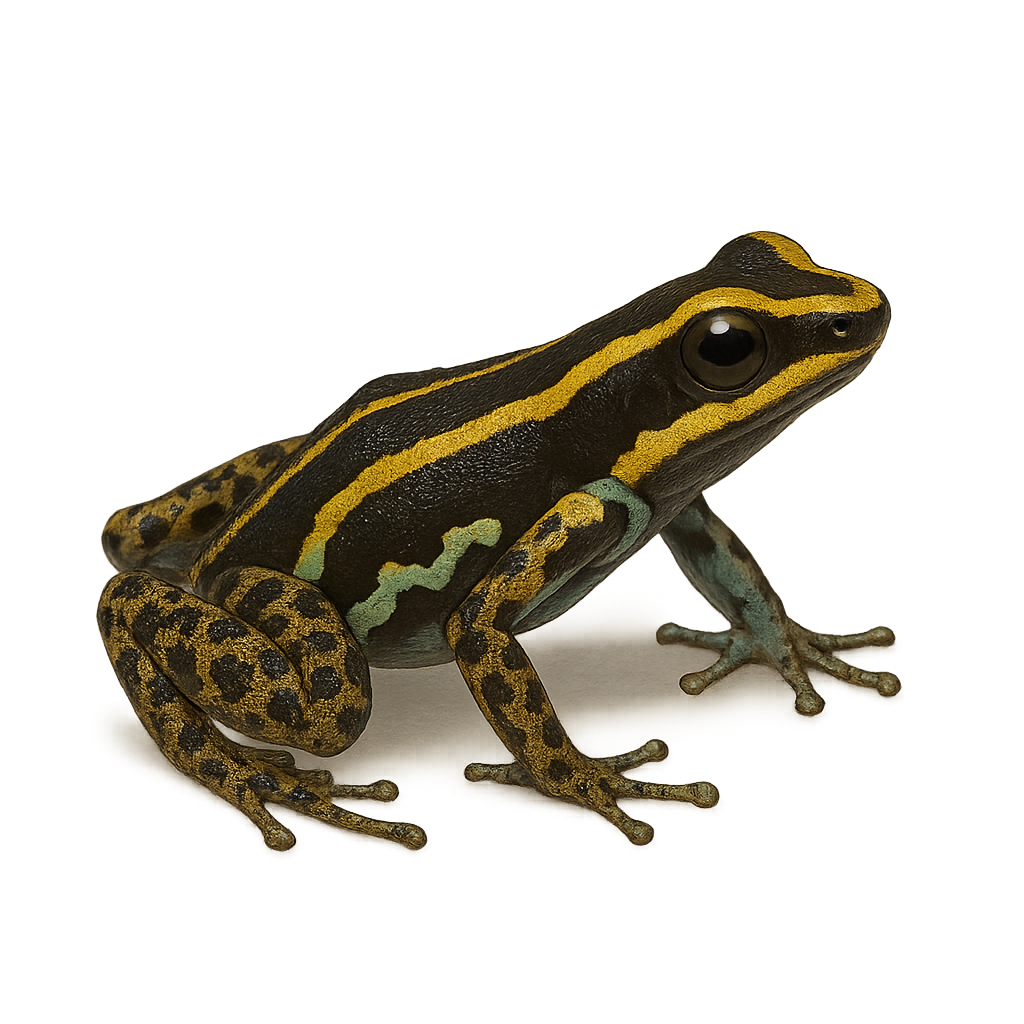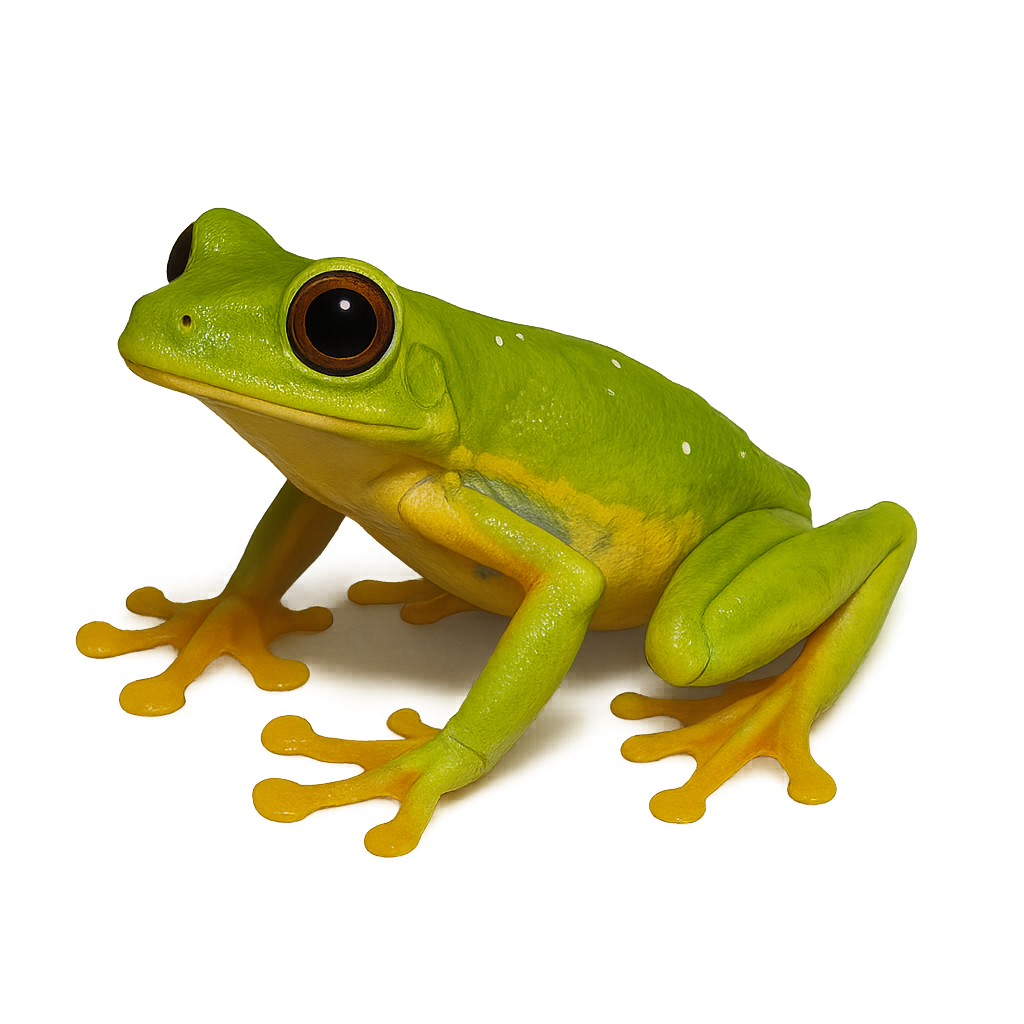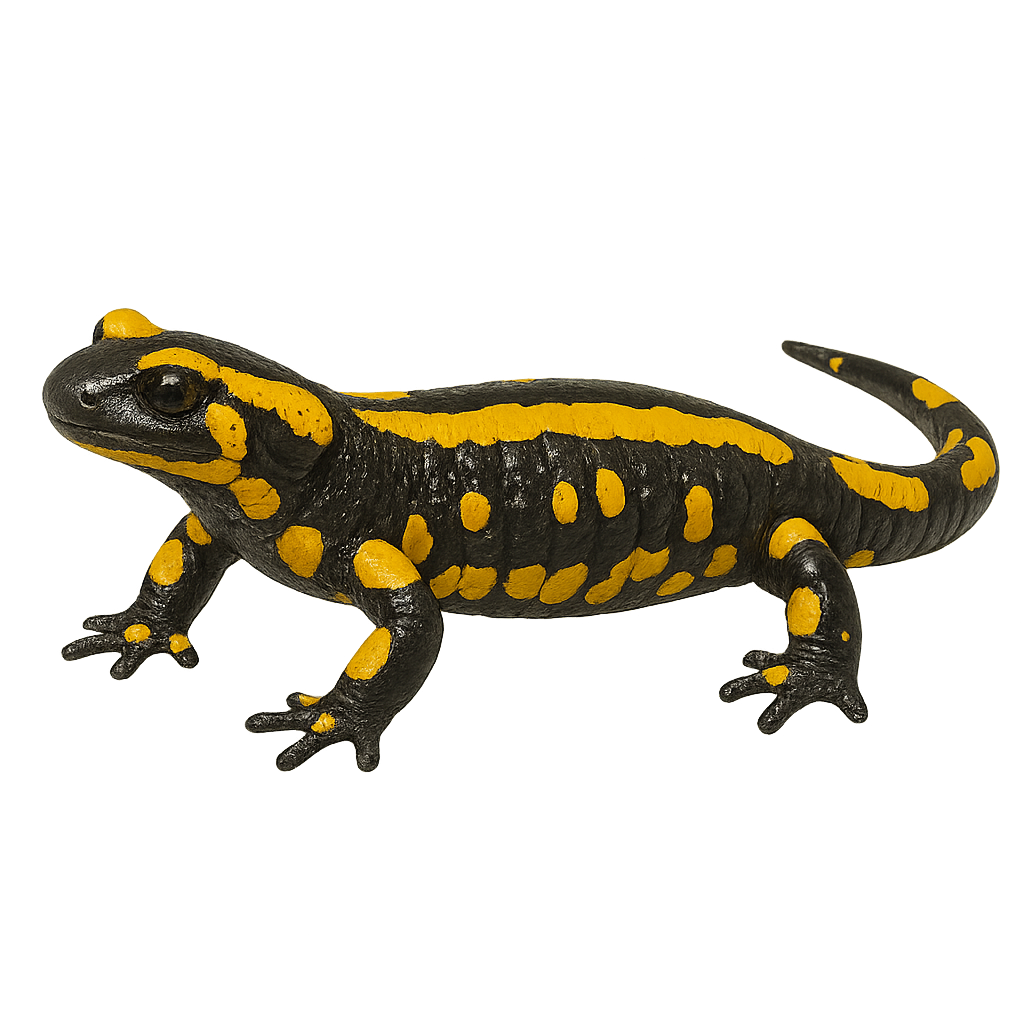The Axolotl is a fascinating species of amphibian native to lakes around Mexico City, Mexico. Unlike most other amphibians, the Axolotl retains its juvenile form throughout its life, a phenomenon known as neoteny. It is famous for its exceptional ability to regenerate parts of its body, including limbs, internal organs, and even its heart. It has a distinctive appearance with its pale pink skin and external gills, giving it the appearance of a small aquatic dragon. The Axolotl primarily lives in cold, deep waters of lakes, where it feeds on small invertebrates.
The Desert Horned Frog is an amphibian species found in the dry, sandy regions of South America, particularly in Argentina, Paraguay, and Uruguay. This toad is easily recognized by the large 'horns' above its eyes, giving it an imposing appearance. It is primarily terrestrial and often hides in the sand or under dead leaves to protect itself from the daytime heat. This frog is a voracious predator, using its large mouth to capture prey as large as small mammals or other amphibians. It is primarily nocturnal and waits until nightfall to hunt.
The Suriname Toad is a fascinating amphibian species, known for its unique appearance and extraordinary reproductive behavior. This flat and wide toad is often called the 'birthing toad' because of the way it carries its eggs on its back, where the tadpoles develop until they are ready to hatch. It primarily lives in slow-moving waters and swamps in the tropical forests of South America, particularly in Colombia, Venezuela, Suriname, and Guyana. Its flat body allows it to hide easily in aquatic substrate, and it is primarily nocturnal. Its skin is a brownish-green, and its appearance allows it to blend perfectly into its aquatic environment.
The Dendrobate, belonging to the Dendrobatidae family, is a small frog known for its bright colors and toxic behavior. These frogs typically measure between 2 and 6 centimeters in length and are easily recognizable by their shiny, colorful skin, which can be yellow, blue, red, or green, depending on the species. They are primarily found in the humid tropical forests of Central and South America. Their diet consists of insects, small arthropods, and occasionally small worms. Dendrobates are known for their toxic secretions, which serve as defense against predators. These toxins mainly come from their diet, particularly ants and beetles that contain alkaloids. Dendrobates are also both terrestrial and aquatic creatures, typically laying their eggs in humid places, where their tadpoles develop in small pools of water or decaying leaves. Although fascinating, Dendrobates are vulnerable to habitat loss due to deforestation and pollution.
The Golden Poison Dart Frog is a small, vibrant, and colorful frog from the Dendrobatidae family. This species typically measures between 2 and 3 centimeters in length and is easily recognized by its golden skin, often speckled with black. It primarily inhabits the humid tropical forests of Central and South America, particularly in Costa Rica and Panama. The Golden Poison Dart Frog feeds mainly on small insects, ants, and mites. It is known for its toxicity, which comes from its diet, particularly from certain ants and beetles that contain alkaloids. These toxins serve as a defense mechanism against predators. This species is also known for its social behaviors and vocalizations during the breeding season. The eggs of the Golden Poison Dart Frog are laid on the forest floor, and the tadpoles develop in small pools of water or on decaying leaves. While this species is not currently endangered, it is threatened by deforestation and the destruction of its natural habitat.

The Strawberry Poison Dart Frog is a small, vibrant, and colorful frog from the Dendrobatidae family. This species typically measures between 2 and 3 centimeters in length and is easily recognizable by its bright red or orange color, sometimes speckled with blue or black, hence its name "strawberry." It is primarily found in the humid tropical forests of Central America, particularly in Costa Rica and Panama. Its diet mainly consists of ants, spiders, and other small arthropods, which it primarily captures from the forest floor. The bright coloration of its skin is an indicator of its toxicity, which comes from alkaloids found in its diet, particularly ants. These toxins serve as protection against predators. During the breeding season, the Strawberry Poison Dart Frog lays its eggs on the forest floor or in humid areas where the tadpoles develop, often in small pools of water or tiny puddles. While this species is not in immediate danger, it is threatened by deforestation, habitat loss, and pollution.
The Dendrobates tinctorius, also known as the Blue Poison Dart Frog, is a vibrant species of toxic frog native to the humid tropical forests of South America, primarily in Guyana, Brazil, and Suriname. This frog is easily recognizable by its bright blue color, which serves as a warning to predators of its toxicity. Dendrobates tinctorius are primarily insectivorous and feed on small insects. Their bright color comes from the toxins of the insects they consume in their natural habitat. In captivity, they are not toxic as their diet changes. This frog is also known for its discreet behavior and primarily nocturnal habits.
The Golden poison dart frog, also known as the Terrible Dart Frog, is considered one of the most toxic animals in the world. Native to the tropical forests of Colombia, this small frog is distinguished by its bright yellow color, which serves as a warning to predators of its toxicity. It derives its toxin from its diet, primarily consisting of insects found in its natural habitat. These frogs are not toxic in captivity as their diet changes. Despite its toxicity, it has been used by some cultures to poison the tips of their arrows, earning it the name 'poison dart frog.'
The Azureus Poison Dart Frog is a brightly colored and striking species, known for its vivid blue color that varies in intensity. Native to the humid tropical forests of Guyana, Suriname, and Brazil, it is famous for its camouflage abilities and skin glands that secrete potent toxins, used for defense against predators. This frog is primarily terrestrial and lives in areas near streams and swamps, where it feeds on insects and other small prey. Due to its coloration, it serves as a warning signal to predators. It is primarily diurnal.
The Helmeted Tree Frog is a fascinating amphibian species, known for the distinctive helmet-like protuberance on its head. This protuberance, resembling a helmet, helps it camouflage among the leaves and branches of trees in the humid tropical forests. It is mainly found in the forests of Costa Rica, Panama, and Nicaragua. It is nocturnal and terrestrial, spending much of its time in the canopy near streams where it lays its eggs. This frog is rather discreet and often hides in dense vegetation to avoid predators.
Baudin's Tree Frog is a fascinating amphibian species, often found in the humid tropical forests of Central America, primarily in Mexico, Costa Rica, and Guatemala. It is easily recognized by its bright coloration, which ranges from light green to yellow, with distinct patterns on the legs and back. This frog is semi-arboreal, meaning it spends part of its time on trees and bushes, near stagnant waters or streams. It is nocturnal and uses its coloration to blend into its environment when resting. It is also capable of making long leaps to escape predators.
The Cochranella Frog is a fascinating amphibian species, known for its translucent skin that allows its internal organs to be visible. Unlike other glass frogs, its skin is slightly granular, which helps it camouflage better in the dense vegetation of its habitat. This frog lives in the humid tropical forests of Central America, mainly in Costa Rica and Panama, where it is found on leaves hanging above streams. Its small size, combined with its discreet behavior, makes it hard to spot. The eggs are laid on leaves above the water, and the tadpoles fall into the stream as they hatch. These frogs are primarily nocturnal and prefer to avoid human interaction.
Darwin's frog is a unique species discovered in Chile and Argentina, famous for its unusual reproductive behavior. After fertilization, males carry the eggs in their mouths until the tadpoles develop into small frogs. They are small in size, brown or green in color, and live in temperate forests, feeding on insects and small invertebrates. The species is threatened by habitat loss and pollution.
Fitzinger's Rain Frog is a terrestrial amphibian species found in the humid tropical forests of Central America, mainly in Costa Rica and Panama. It is known for its rough skin and typically gray-brown coloration, which helps it blend seamlessly into its environment. This frog is nocturnal and prefers to live in damp understory areas, where it hides under dead leaves or rocks. Its small size, combined with its discreet behavior, makes it hard to spot. Unlike other tree frogs, it is primarily terrestrial and spends most of its time on the ground, near temporary water sources where it lays its eggs.
The Glass Frog is a fascinating species of amphibian, known for its translucent skin that allows its internal organs to be visible. It typically measures between 2 and 3 cm long and is commonly found on leaves hanging above streams in the tropical rainforests of Central and South America. Its transparent skin serves as an excellent camouflage, helping it blend seamlessly into its environment. This frog’s ability to blend with the vegetation, combined with its small size, makes it hard to spot. Its eggs are laid on leaves above water, and the tadpoles fall into the water once they hatch. This species is nocturnal and somewhat shy, preferring to avoid human interaction.
The Goliath frog is the largest amphibian in the world, capable of measuring up to 32 cm in length and weighing over 3 kg. Native to the rivers and swamps of Cameroon and Gabon, it primarily feeds on insects, fish, and occasionally small mammals. Its large size and rough green skin make it a formidable predator, but it remains discreet and prefers to stay submerged in water. Although not critically endangered, the Goliath frog faces pressures due to habitat destruction.
The Vietnamese Mossy Frog is a unique amphibian species, easily recognized by its rough skin and green coloration that resembles moss, providing it with perfect camouflage in its natural habitat. This frog lives in the humid forests of Vietnam, particularly in rocky areas and trees. It is primarily nocturnal, spending the day motionless, camouflaged among leaves or moss. When it moves at night, it is capable of climbing vertical surfaces thanks to its sharp claws, making it an excellent climber. Its coloration and skin texture help it blend into its environment and avoid predators.
The Common Frog is a widespread species of frog in Europe, easily recognized by its brown or green skin, often spotted with dark markings. It primarily lives in wetland areas such as marshes, ponds, and riverbanks. This frog is an opportunist, feeding mainly on insects, worms, and small invertebrates that it captures with its quick tongue. The Common Frog is often seen during its movements toward water for breeding, a characteristic behavior in spring. It is active during the day and evening, although its habits are more pronounced during the breeding season.
The Tomato Frog is a striking amphibian species native to Madagascar, easily recognizable by its bright red color and large skin glands that secrete a toxic mucus when threatened. These frogs grow to about 10 cm and are primarily terrestrial, living in the dry tropical forests and savannas of Madagascar. Their bright coloration serves as a warning signal to predators. They are nocturnal and spend the day hiding under leaves or in burrows to avoid heat and predators. During the breeding season, they gather near water sources where they lay their eggs.
Boulenger's Poison Frog is an amphibian species native to the tropical forests of Brazil. It is primarily recognizable by its bright color and distinctive skin patterns, which range from bright yellow to green. These frogs produce a potent venom that protects them from predators. It is primarily terrestrial and lives in humid, wooded areas, often near streams. The Boulenger’s Poison Frog is nocturnal, hiding under leaves or in ditches during the day to avoid the heat of the sun. Its bright color also serves as a warning signal to predators.
Wallace's Flying Frog is a remarkable amphibian species, famous for its ability to glide from tree to tree. This frog, with long and flexible limbs, has wide feet with membranes that allow it to stabilize itself in flight. It primarily lives in the humid tropical forests of Malaysia, Indonesia, and Borneo. It feeds on insects while suspended in the branches of trees. During the breeding season, it moves to ponds or streams to lay its eggs. Wallace's Flying Frog is also nocturnal and uses its flight to escape predators.
The Lovely Poison Frog is a small, diurnal terrestrial frog, measuring about 2.5 cm in length. Its body is black with two bright yellow to orange longitudinal stripes on the back, and blue-green marbling on the flanks and limbs. This species inhabits lowland humid forests, often near slow-moving streams, between 10 and 650 m elevation. It primarily feeds on small invertebrates such as ants and spiders. Although its skin contains toxic alkaloids, including batrachotoxins, their concentration is low and sometimes undetectable. The Lovely Poison Frog is listed as Least Concern by the IUCN, but is locally threatened by deforestation and pollution.
The Red-eyed Tree Frog is a small arboreal frog primarily found in the humid tropical forests of Central and South America, particularly in Costa Rica and Panama. It measures about 5 to 7 cm in length and weighs between 10 and 20 g. Its body is generally green, with yellow or blue spots on the sides, and its eyes are bright red, making it a particularly recognizable species. The Red-eyed Tree Frog is insectivorous, primarily feeding on flying insects like mosquitoes and flies. It is nocturnal and spends the day hidden in foliage or tree crevices. While its population remains stable in certain protected areas, it is still threatened by deforestation and pollution of its natural habitat.
The Gliding Tree Frog is a medium-sized nocturnal arboreal frog, measuring between 5 and 8 cm. It has bright green dorsal coloration during the day, turning darker at night, with orange or bluish hues on its flanks and limbs. Its large red eyes and webbed feet enable it to "fly" from tree to tree by gliding. This species inhabits humid tropical forests in Costa Rica, Panama, Colombia, and Ecuador, between 15 and 750 m elevation. It resides in the canopy and descends to the ground to breed in temporary pools formed by rains. Breeding is explosive, with thousands of individuals gathering in a single night to lay eggs on leaves overhanging water. Tadpoles fall into the water upon hatching. Although listed as Least Concern by the IUCN, this species is locally threatened by deforestation and habitat loss.
The Japanese giant salamander is one of the largest salamanders in the world, reaching lengths of up to 1.5 meters. It lives in cold rivers and mountain streams in Japan, primarily in the regions of Honshu and Shikoku. This nocturnal predator feeds mainly on fish, crustaceans, and aquatic insects. Due to its imposing appearance and secretive behavior, this salamander is often difficult to spot. It is protected due to habitat loss and river pollution.
The Spotted Salamander is an amphibian primarily found in forests and wetlands across Europe, particularly in France, Spain, and Germany. It typically measures between 15 and 25 cm in length, although some specimens can reach up to 30 cm. Its body is black with bright yellow spots, making it easily identifiable. The Spotted Salamander is a nocturnal and terrestrial animal, hiding during the day under rocks or in holes in the ground to protect itself from the heat. It is carnivorous and feeds primarily on insects, worms, small crustaceans, and other invertebrates. While it remains relatively abundant in certain regions, this species is threatened by water pollution, habitat destruction, and climate change.



